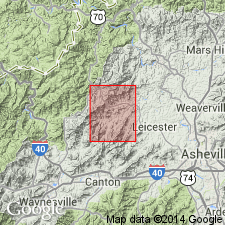
- Usage in publication:
-
- Earlies Gap Biotite Gneiss
- Modifications:
-
- Named
- Dominant lithology:
-
- Gneiss
- Amphibolite
- AAPG geologic province:
-
- Piedmont-Blue Ridge province
Summary:
Earlies Gap Biotite Gneiss is here defined and formally named in the central Blue Ridge of NC. It is one of five map units composing the Middle Proterozoic basement sequence that underlies 60% of the study area. The Earlies Gap crops out over much of the northern one-half of the Canton quad. and continues in a 2-mi wide band through the eastern part of the Sandymush quad. These rocks have previously been mapped as Carolina Gneiss and Roan Gneiss by Keith (1904), layered gneiss and migmatite by Hadley and Nelson (1971), and biotite granitic gneiss by the NC Geological Survey (1985). Unit is distinctly layered, heterogeneous, migmatitic, folded, and highly jointed. Biotite gneiss, the dominant lithology, varies from very light to medium light gray reflecting biotite abundance. Amphibolite, the second most abundant rock type, occurs as thin layers, lenses, and pods. Unit is at least 4,000 m thick. Contact between the Earlies Gap and rocks of the Ashe Metamorphic Suite is the Holland Mountain thrust fault. Contact with the Sandymush Felsic Gneiss (new name) is gradational. Age is estimated at 1.2 to 1.3 b.y. based on correlation with dated rocks in Mars Hill quad.
Source: GNU records (USGS DDS-6; Reston GNULEX).
For more information, please contact Nancy Stamm, Geologic Names Committee Secretary.
Asterisk (*) indicates published by U.S. Geological Survey authors.
"No current usage" (†) implies that a name has been abandoned or has fallen into disuse. Former usage and, if known, replacement name given in parentheses ( ).
Slash (/) indicates name conflicts with nomenclatural guidelines (CSN, 1933; ACSN, 1961, 1970; NACSN, 1983, 2005, 2021). May be explained within brackets ([ ]).

